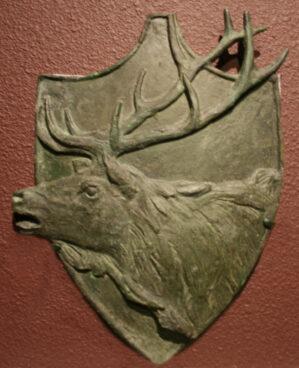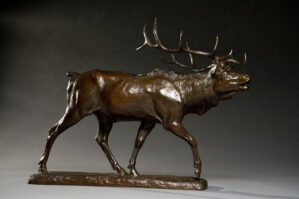The Challenge; Elk-Challenge; The Challenge-Elk; American Elk; Elk Challenging; The Challenged Elk
Banner Image: Alexander Phimister Proctor
Elk, ca. 1899
Bronze, 17 in. (height). Buffalo Bill Center of the West, Cody, Wyoming. Gift of A. Phimister Proctor Museum with special thanks to Sandy and Sally Church. 2.16.1. Photography by William J. O’Connor
Proctor’s Elk was first modeled around 1899, probably before he left for his second trip to Paris. American writer Georgia Fraser saw the model for this work in Proctor’s Paris studio in early 1900. It was still a plaster, not having been cast in bronze yet, and it had lost its antlers in shipment to France. Even though confronting it in this preliminary and compromised state, Fraser was still impressed. Proctor’s “modeling of animals is never at fault,” she wrote, and “it speaks volumes for the artist that the beautiful creature has lost none of its dignity by the loss of its horns en voyage.”[1]
A bronze casting of it was exhibited as The Challenge—Elk in the American pavilion at the 1900 Paris Exposition Universelle, as part of an ensemble of eight sculptures that garnered Proctor a gold medal.[2] The elk’s authoritative stance and maturity, combined with the aggressive expanded title, mark this work as the absolute antithesis of his bronze of the frail Young Fawn, also displayed at the exposition. Here is a full-grown male wapiti asserting his vigor and prowess as a leader of his herd. It was evidence of the breadth of Proctor’s themes and the systemic complexity that he saw in nature. The Elk pictured an animal that could survive and perpetuate himself even in the face of Proctor’s most adversarial wild protagonists, such as his Stalking Panther.
Subsequent writers saw the contrast between Proctor’s Young Fawn and Elk as a metaphor for what many people of the era perceived as nature’s fundamental construct, the Darwinian notion of survival of the fittest. In 1910, a Toronto critic illustrated a casting of The Challenge next to a photograph of Proctor, noting that the artist was uncommonly “able to inspire his figures with the life and spirit of the wilderness.” Yet when the critic chose to discuss the Fawn, it was with a strong sense of denouement. “The little figure is an exquisite expression of the grace and the shivering timidity of forest life. It contains all the tragedy of its race.”[3] Survival seemed not to be in the cards for the baby deer.

Plate 5.1 — Unknown Photographer
Proctor with bull elk, 1883
Photograph, b&w. Alexander Phimister Proctor Collection, MS 242, Harold McCracken Research Library, Buffalo Bill Center of the West, Cody, Wyoming. P.242.346
In later years, Proctor would write of a life-and-death experience that occurred when he was a boy and, in the Colorado Rockies, shot his first bull elk. [Plate 5.1] When his first shot only wounded the elk, the hunter became the hunted, and Proctor narrowly survived the scrape. On the same day, he killed and was nearly killed by a grizzly bear as well.[4] There was no distance, nor had there ever really been any, between the artist and that “life and spirit of the wilderness” with which the Toronto critic visually and symbolically allied Proctor and his elk sculpture. Nature’s raw domain was truly the artist’s province.

Plate 5.2 — Alexander Phimister Proctor
Elk, ca. 1912
Painted plaster plaque, 13 1/2 in. (height). Buffalo Bill Center of the West, Cody, Wyoming. Gift of A. Phimister Proctor Museum with special thanks to Sandy and Sally Church. 4.12
Castings of this work are marked on the artist’s base with a copyright date of 1899. Records from the copyright files at the Library of Congress, however, suggest that an application for copyright may not have been submitted until a decade later, in 1909. In February of that year Proctor was granted a copyright for what he referred to as “Elk. A small statue.”[5] The work was known variously in its exhibition history as The Challenge and The Challenge—Elk.[6] A high relief plaster plaque of the elk’s head was made for a bronze that the artist was thought to have sold to Gifford Pinchot in 1912. [Plate 5.2] It was copyrighted that year also as “The Challenge” and was defined simply as an “Elk in bronze.”[7]
About a third of the half-dozen known castings of Elk were made with the lost-wax method by Pompeian Bronze Works in New York before 1913. [Plate 5.3]

Plate 5.3 — Alexander Phimister Proctor
Elk, ca. 1912
Bronze, 16 1/2 in. (height). Brooklyn Museum, Brooklyn, New York. Gift of George D. Pratt. 12.987
In the early 1900s Proctor also used Roman Bronze Works to cast the piece in lost wax. At least as many as four of those appear to have been made, as the one known Roman Bronze Works casting is marked no. 4 and dates from around 1904. Only one Gorham Co. Founders sand-cast version is known to exist, an example of post-1913 manufacture. It served as a metal pattern for subsequent casts and was patinaed later. [Plate 5.4]

Plate 5.4 — Alexander Phimister Proctor
Elk, ca. 1904
Bronze, 17 in. (height). Buffalo Bill Center of the West, Cody, Wyoming. Gift of A. Phimister Proctor Museum with special thanks to Sandy and Sally Church. 2.16.1
[1] Georgia Fraser, “The Sculptors of the United States Pavilion at the Paris Exposition,” Brush and Pencil, 5 (February 1900), 234.
[2] Official Illustrated Catalogue: Fine Arts Exhibit, United States of America, Paris Exposition of 1900, no. 44.
[3] “A Successful Canadian Sculptor.”
[4] Ebner, Sculptor in Buckskin, 34–40.
[5] Copyright record 28272, filed February 4, 1909, with the Library of Congress.
[6] Listed in 1901 under the title The Challenge, it was the first bronze he ever exhibited at the National Academy of Design. See Peter Hastings Falk (ed.), The Annual Exhibition Record of the National Academy of Design, 1901–1950 (Connecticut: Sound View Press, 1990), 426.
[7] Copyright record 42236, filed November 21, 1912, with the Library of Congress.